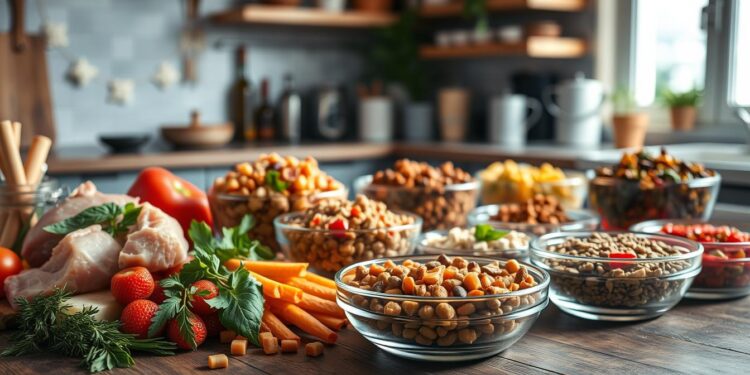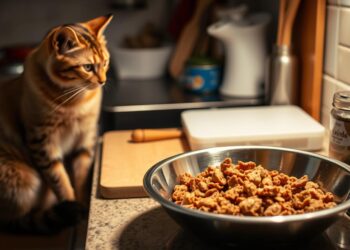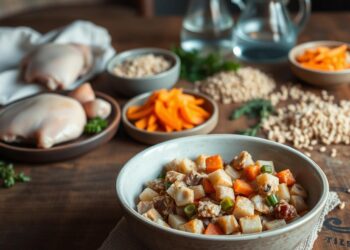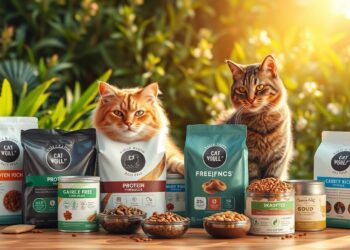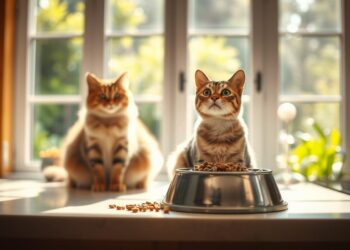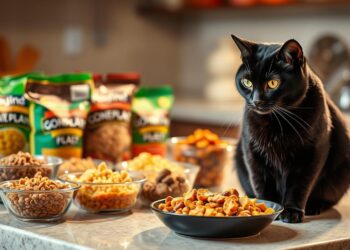As a cat owner, ensuring your pet’s nutritional needs are met is crucial for their overall health and wellbeing. Cats are obligate carnivores, requiring a diet rich in protein from animal sources. Essential amino acids like taurine, found in meat, play a critical role in maintaining heart health.
Preparing healthy meals for your cat at home can be a rewarding experience, allowing you to control the ingredients and tailor the nutrition to your cat’s specific needs. By understanding the basics of a balanced feline diet, you can create nutritious and delicious meals that support your cat’s health.
This guide will walk you through the fundamentals of creating homemade cat food recipes, highlighting the importance of a balanced mix of fats, limited carbs, and essential vitamins and minerals.
Why Choose Homemade Cat Food?
Preparing homemade cat food allows owners to have complete control over the ingredients, ensuring their cat’s nutritional needs are met. This approach to cat nutrition is becoming increasingly popular as pet owners seek healthier, more natural options for their pets.
Benefits of Homemade Recipes
One of the primary advantages of homemade cat food is the ability to tailor the diet to the cat’s specific needs. By choosing easy cat food recipes, owners can ensure their pets receive the necessary nutrients without the preservatives often found in commercial cat foods. Additionally, homemade recipes allow for the use of fresh, natural ingredients that can improve the overall health and well-being of the cat.
Homemade cat food can also be beneficial for cats with allergies or sensitivities. By controlling the ingredients, owners can identify and avoid potential allergens, reducing the risk of adverse reactions. Furthermore, natural cat food recipes often result in a more palatable meal for cats, potentially increasing their appetite and enjoyment of mealtime.
Understanding Your Cat’s Nutritional Needs
Cats are obligate carnivores, requiring a diet rich in protein from animal sources. Understanding these nutritional needs is crucial for creating a balanced homemade cat food recipe. Cats require certain amino acids, such as taurine, which are found in animal-based ingredients. Ensuring that homemade recipes include these essential nutrients is vital for maintaining the cat’s health.
A well-balanced homemade cat food should also consider the cat’s life stage, lifestyle, and any health conditions. For example, kittens require more protein and calories than adult cats, while older cats may need fewer calories but more joint support. Consulting with a veterinarian or a certified animal nutritionist can help owners develop a tailored diet that meets their cat’s specific nutritional requirements.
Safe Ingredients for Cat Food
The key to a healthy homemade cat food recipe lies in understanding which ingredients are safe and beneficial for your cat. Cats are obligate carnivores, meaning they require a diet rich in protein from animal sources. Therefore, it’s essential to choose ingredients that meet their nutritional needs while avoiding harmful substances.
Best Proteins for Cats
Cats require high-quality protein sources, such as chicken, beef, and fish. These proteins provide essential amino acids that cats cannot produce on their own. When selecting protein sources, it’s crucial to choose fresh, lean meats to minimize the risk of contamination and maximize nutritional value.
Chicken is a popular choice due to its high protein content and low fat levels. Beef is another excellent option, providing a rich source of iron and other essential minerals. Fish, such as salmon, is not only a great protein source but also rich in omega-3 fatty acids, which support skin and coat health.
Essential Vitamins and Minerals
In addition to protein, cats require various vitamins and minerals to maintain overall health. Omega-3 fatty acids, found in fish oil, support heart health and reduce inflammation. Vitamin E is crucial for maintaining healthy skin and coat, while taurine, an amino acid found in animal-based ingredients, supports heart health and vision.
- Omega-3 fatty acids: Supports heart health and reduces inflammation
- Vitamin E: Maintains healthy skin and coat
- Taurine: Supports heart health and vision
Foods to Avoid
While many human foods are safe for cats, some can be toxic. It’s essential to avoid feeding your cat onions, garlic, and chives, as they belong to the Allium family and can cause damage to a cat’s red blood cells. Other foods to avoid include chocolate, grapes, and raisins, which are known to be toxic to cats.
By understanding which ingredients are safe and beneficial, you can create a well-balanced and nutritious homemade cat food that meets your cat’s dietary needs.
Simple Homemade Cat Food Recipes
With a few simple ingredients, you can create delicious and healthy homemade cat food recipes that your cat will love. These recipes are not only easy to prepare but also allow you to tailor your cat’s meals to their specific dietary needs and preferences.
Chicken and Rice Recipe
A classic and straightforward recipe is chicken and rice, which is gentle on your cat’s stomach and provides essential nutrients. To prepare this recipe, you will need:
- 1 pound of boneless, skinless chicken breast or thighs
- 1 cup of cooked white or brown rice
- 1/2 cup of finely chopped carrots
- 1/4 cup of green beans
Simply cook the chicken thoroughly, mix it with the cooked rice and vegetables, and serve. This recipe is a great starting point for cats who are new to homemade food.
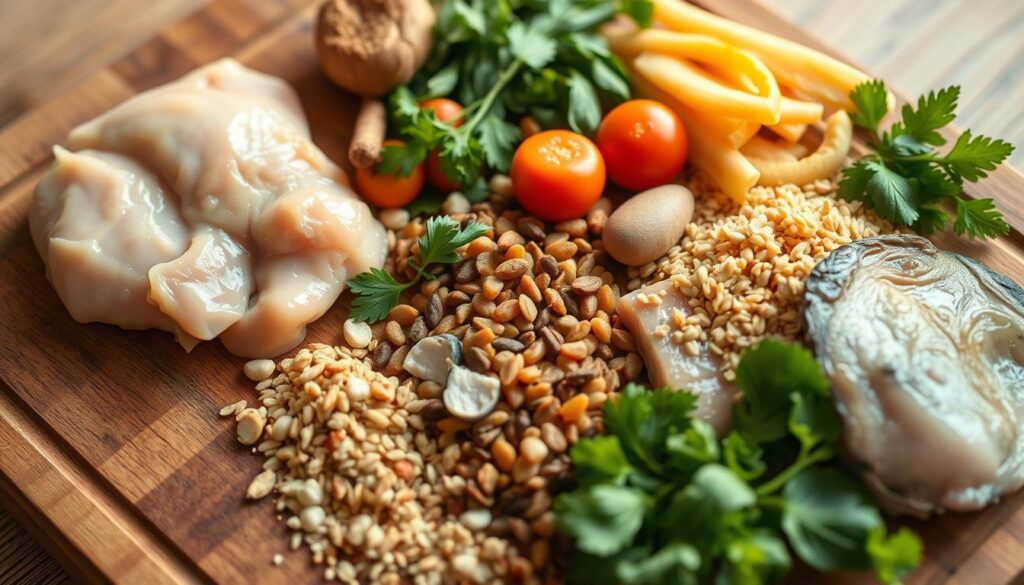
Tuna Delight Recipe
Cats often love the taste of tuna, making it a great ingredient for homemade cat food. For the Tuna Delight Recipe, you will need:
- 1 can of tuna in water (drained and flaked)
- 1/4 cup of finely chopped hard-boiled egg
- 1/4 cup of cooked brown rice
- 1 tablespoon of olive oil
Mix all the ingredients together and serve. This recipe is rich in protein and can be a nutritious addition to your cat’s meal rotation.
Beef and Vegetable Stew
For a heartier meal, consider the Beef and Vegetable Stew. This recipe includes:
- 1 pound of ground beef or finely chopped beef
- 1/2 cup of mixed vegetables (such as peas, carrots, and sweet potatoes)
- 1/4 cup of cooked brown rice
Cook the beef until it’s fully browned, then add the mixed vegetables and cooked rice. This stew is a nutritious and filling meal that can be served alone or mixed with your cat’s regular food.
Preparing and Cooking Techniques
The way you prepare and cook your cat’s food is crucial for maintaining its nutritional value. Proper cooking techniques not only ensure the food is safe for consumption but also help preserve the nutrients.
Safe Cooking Practices
When preparing homemade cat food, it’s essential to follow safe cooking practices to avoid contamination. Always wash your hands before handling ingredients, and make sure all utensils and cooking surfaces are clean.
- Use fresh and high-quality ingredients.
- Avoid cross-contamination by separating raw meat, fish, and other ingredients.
- Cook food to the appropriate temperature to kill bacteria.
Recommended Cooking Methods
Cooking methods like baking and steaming are highly recommended for preparing cat food as they help retain the nutrients. Baking is a simple method that allows for even cooking, while steaming preserves the moisture and flavor of the ingredients.
| Cooking Method | Nutrient Retention | Ease of Preparation |
|---|---|---|
| Baking | High | Easy |
| Steaming | Very High | Moderate |
| Boiling | Moderate | Easy |
Proper Food Storage
After cooking, it’s crucial to store the food properly to maintain its freshness and safety. Use airtight containers and store them in the refrigerator or freezer.
- Refrigerate cooked food within two hours of cooking.
- Use freezer-safe containers for long-term storage.
- Label containers with the date and contents.
By following these guidelines, you can ensure that your homemade cat food is not only delicious but also safe and nutritious for your pet.
Ensuring Nutritional Balance
Creating a balanced homemade cat food recipe involves understanding your cat’s nutritional needs and meeting them appropriately. Cats are obligate carnivores, requiring a diet rich in protein from animal sources. Ensuring nutritional balance is critical to maintaining your cat’s overall health, whether you’re preparing food for a cat with a sensitive stomach or aiming for weight loss through homemade cat food.
Importance of Protein Ratios
Protein is a crucial component of a cat’s diet. The ideal protein ratio can vary based on factors such as age, health, and activity level. Generally, cats require a significant amount of protein from animal sources like chicken, fish, or beef. A well-balanced homemade cat food recipe should include a protein source as the main ingredient.
Example of Protein Sources and Their Benefits:
| Protein Source | Nutritional Benefits |
|---|---|
| Chicken | High-quality protein, rich in essential amino acids |
| Salmon | Rich in omega-3 fatty acids, supports skin and coat health |
| Beef | High in iron and protein, supports muscle health |
Adding Supplements
While whole foods should be the primary source of nutrition, certain supplements can help fill any nutritional gaps in your cat’s diet. Supplements such as omega-3 fatty acids, vitamin E, and taurine can be beneficial. However, it’s essential to consult with a veterinarian before adding any supplements to ensure they are necessary and safe for your cat.
Common Supplements for Cats:
- Omega-3 fatty acids for skin and coat health
- Taurine for heart health
- Vitamin E for antioxidant benefits
Consulting a Veterinarian
Before making any significant changes to your cat’s diet, it’s crucial to consult with a veterinarian. They can provide guidance on creating a balanced diet that meets your cat’s specific needs, whether you’re preparing homemade cat food for sensitive stomachs or for weight loss. Regular check-ups can also help monitor your cat’s health and adjust the diet as needed.
By understanding the importance of nutritional balance, maintaining the right protein ratios, and knowing when to add supplements, you can create a healthy and balanced homemade cat food diet. Always consult with a veterinarian to ensure your cat’s dietary needs are being met.
Treats and Snacks for Your Cat
Rewarding your cat with healthy treats is an excellent way to promote good behavior and strengthen your bond. Homemade cat treats can be a fun and rewarding way to ensure your cat is getting the best snacks possible.

Easy DIY Cat Treats
Creating your own cat treats at home can be simple and enjoyable. You can use ingredients like chicken, salmon, and sweet potatoes to make delicious and healthy treats. Homemade treats allow you to control what goes into them, ensuring they are free from preservatives and additives found in some commercial products.
Here’s a simple recipe to get you started: Mix cooked chicken with some olive oil and a bit of flour to form a dough. Roll it out, cut into shapes, and bake until crispy. These treats are not only tasty but also provide a good source of protein for your cat.
Ingredients for Healthy Snacks
When making natural cat food recipes, it’s essential to choose ingredients that are safe and nutritious for your cat. Some excellent options include:
- Lean proteins like chicken, turkey, and fish.
- Vegetables such as green beans, carrots, and pumpkin.
- Fruits like apples and blueberries (in moderation).
- Whole grains like brown rice and oats.
Always avoid using ingredients that are toxic to cats, such as onions, garlic, and chocolate.
Storage Tips for Treats
Proper storage is crucial to maintaining the freshness and safety of your homemade cat treats. Store them in airtight containers to keep them fresh for longer. You can also freeze treats to extend their shelf life. When freezing, it’s a good idea to portion them out into individual servings so you can thaw only what you need.
By following these tips and using natural ingredients, you can provide your cat with healthy and delicious treats that complement their regular diet.
Special Dietary Needs
Homemade cat food offers a personalized approach to managing feline dietary needs, especially for cats with sensitivities. Cats with unique health conditions, such as sensitive stomachs or allergies, require careful consideration when it comes to their diet. By preparing homemade cat food, owners can tailor recipes to meet their cat’s specific needs, ensuring they receive the necessary nutrients without the ingredients that cause adverse reactions.
Recipes for Sensitive Stomachs
Cats with sensitive stomachs benefit from diets that are easy to digest and rich in nutrients. A simple recipe for a sensitive stomach includes boiled chicken, cooked rice, and steamed vegetables. This combination is gentle on the digestive system while providing essential proteins and vitamins.
To prepare this recipe, boil boneless, skinless chicken breast until it’s fully cooked. Serve it with a small amount of cooked white rice and steamed carrots or green beans. This meal is not only easy on the stomach but also provides a balanced mix of protein, carbohydrates, and fiber.
Options for Allergies
Cats with allergies require diets that avoid common allergens such as beef, dairy, or fish. Novel protein sources like venison or duck can be excellent alternatives. A recipe for cats with allergies might include venison, sweet potatoes, and peas.
To make this recipe, cook venison steaks until they’re well done, then serve them with mashed sweet potatoes and steamed peas. This combination is not only hypoallergenic but also rich in essential nutrients, making it a healthy option for cats with dietary allergies.
Low-Calorie Recipes
For cats that need to manage their weight, low-calorie homemade recipes can be very effective. A low-calorie recipe might include lean turkey, cauliflower, and a small amount of brown rice. This combination is low in calories but high in fiber and protein, helping cats feel full without consuming too many calories.
To prepare this low-calorie meal, cook lean ground turkey until it’s fully browned, then mix it with steamed cauliflower and a small serving of cooked brown rice. This recipe is not only low in calories but also rich in nutrients, making it an ideal option for cats on a weight management diet.
Transitioning Your Cat to Homemade Food
Introducing homemade cat food into your cat’s meal plan can be a healthy decision if done correctly. A gradual transition is crucial to prevent digestive upset and ensure your cat adapts well to the new diet.
Steps for a Smooth Transition
To transition your cat smoothly, start by mixing a small amount of homemade cat food with their current diet. Gradually increase the proportion of homemade food over 7-10 days. This gradual introduction helps your cat’s digestive system adjust.
- Day 1-2: 25% homemade food, 75% current diet
- Day 3-4: 50% homemade food, 50% current diet
- Day 5-6: 75% homemade food, 25% current diet
- Day 7 and beyond: 100% homemade food
Monitoring Your Cat’s Health
It’s essential to monitor your cat’s health during this transition. Watch for signs of digestive upset, such as diarrhea or vomiting, and adjust the transition pace as needed. Regular check-ups with your veterinarian can also provide valuable insights into your cat’s health.
| Health Indicator | Normal | Abnormal |
|---|---|---|
| Stool Quality | Firm, well-formed | Diarrhea, very soft |
| Vomiting | None or occasional hairballs | Frequent vomiting |
| Appetite | Good, consistent | Decreased, picky |
Adjusting Recipes as Needed
If your cat shows signs of not tolerating the homemade diet, it may be necessary to adjust the recipes. Consider consulting with a veterinarian or a pet nutritionist to ensure the diet remains balanced and meets your cat’s nutritional needs.
By following these steps and being attentive to your cat’s response, you can successfully transition them to a homemade diet. Remember, every cat is different, so patience and flexibility are key.
Frequently Asked Questions
Cat owners often have numerous questions about transitioning to homemade cat food recipes. As you consider making the switch, it’s natural to have concerns about the best practices for feeding your cat. Here, we’ll address some of the most common questions to help guide you through the process.
How much homemade food should I feed?
Determining the right amount of homemade food for your cat depends on several factors, including age, weight, and activity level. Generally, cats require 2-4% of their body weight in food per day. For example, a 10-pound cat would need 2.5 to 5 ounces of food daily. It’s essential to monitor your cat’s weight and adjust the feeding amount accordingly to maintain optimal health.
Can I add human food to cat meals?
While it’s tempting to share human food with your cat, it’s crucial to do so cautiously. Some human foods are safe and healthy for cats, such as cooked chicken or green beans. However, others can be toxic. Always research or consult with a veterinarian before adding human food to your cat’s diet to ensure you’re making safe choices.
How often should I change recipes?
Varying your cat’s recipes can help ensure they receive a broad spectrum of nutrients. It’s a good idea to rotate between different healthy cat food recipes every few weeks. This rotation can help prevent sensitivities and keep your cat’s diet interesting. However, any changes should be made gradually to prevent digestive upset.
By understanding the answers to these common questions, you can confidently provide your cat with nutritious, homemade meals that support their overall health and well-being.
Time-Saving Tips for Busy Cat Owners
For busy cat owners, preparing homemade cat food can seem daunting, but with the right strategies, it can be a breeze. By implementing a few simple techniques, you can ensure your cat enjoys healthy, homemade meals without spending hours in the kitchen.
Batch Cooking Ideas
Batch cooking is an excellent way to save time while still providing your cat with a variety of meals. By cooking large batches of food at once, you can portion out individual servings and store them in the freezer for later use. This method not only saves time but also ensures consistency in your cat’s diet.
- Cook large batches of your cat’s favorite recipes.
- Portion out individual servings into airtight containers.
- Store containers in the freezer for up to 3 months.
Meal Prepping for Cats
Meal prepping is another effective strategy for busy cat owners. By preparing your cat’s meals in advance, you can ensure they’re getting the nutrients they need without the daily hassle of cooking. Consider setting aside one day a week to prep your cat’s meals for the next few days.
Tips for meal prepping:
- Choose simple, nutritious recipes.
- Prepare ingredients in advance, such as chopping vegetables or cooking proteins.
- Assemble and store meals in the refrigerator or freezer.
Quick Recipe Suggestions
For those days when time is especially scarce, having a few quick and easy recipes on hand can be a lifesaver. Consider simple DIY cat food recipes that require minimal ingredients and preparation time. Some ideas include:
- A simple chicken and rice bowl.
- A tuna salad made with canned tuna, olive oil, and chopped parsley.
- A beef and vegetable stew cooked in a slow cooker.
For cats needing homemade cat food for weight loss, consider recipes that are lower in calories but still nutrient-rich. For example, you can make a weight management cat food by using lean proteins and reducing the amount of carbohydrate-rich ingredients.
Resources and References
For cat owners who want to continue exploring the world of homemade cat food, there are numerous resources available. Whether you’re looking for vet-approved cat food recipes or seeking guidance on natural cat food recipes, these references can provide valuable insights.
Recommended Reading
Several books offer comprehensive guides on preparing homemade cat food. These resources cover topics from nutritional requirements to simple recipes, ensuring a well-rounded understanding of feline dietary needs.
Online Resources
Websites dedicated to cat nutrition provide a wealth of information, including vet-approved cat food recipes and natural cat food recipes. These sites can be a great resource for cat owners looking to diversify their cat’s diet.
Expert Advice
Connecting with cat nutrition experts can offer personalized advice and guidance. Many veterinarians and animal nutritionists share their knowledge online, providing tips on creating balanced and healthy homemade cat food.
